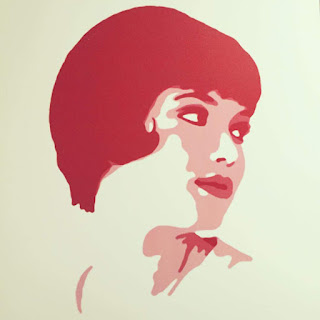Germany in the 1920's . The Weimar
Republic was a hub of artistic expression and the population eager for change in
the aftermath of WWI. Filmmakers were creating a new cinematic
language referred to as the German Expressionist Movement. Films applied askew camera angles, outlandish set
pieces, eccentric characters, and stories that dealt with the
landscape of the mind. Control, murder, paranoia, fear, madness, and
betrayal were all reoccurring themes and no one expressed these ideas
better than director Fritz Lang.
 |
| Fritz Lang on the set of M. |
I have
chosen three films that demonstrate Lang's themes and talent as a visual
filmmaker. The Three M's, as
I call them, are; Metropolis,
M, and Ministry
Of Fear. Lang is thought of by many film scholars as a prophet with spiritual and political insight. It is easy to see his vision of a world on the verge of collapse in these three films.
 |
| Sketch for the set design of M. |
Lang's
groundbreaking Metropolis (1927)
showed audiences a society where the rich live carefree and
gluttonous above ground while underneath, slaves toil endlessly to keep
the machines of the great metropolis operable. Metropolis
creates a stark contrast between the beautiful architecture of the
elite society and the dark machine world of the slaves.
 |
| The underground slaves arriving for work in their smoke stack machine. |
 |
| A robot made in the form of a human and surrounded by "circles" of power in Metropolis |
Geometry was central to Lang's style ; angles and shapes express
feelings. Most prevalent are the repetition of circles that work
against the sharp pointed lines of the buildings and interior set
pieces. The characters are often surrounded by extreme inanimate
objects or crowds of people, buildings or smoke filled machines,
creating claustrophobia and the feeling that both the rich and the
poor are trapped in these shapes and doomed to repeat their history.
 |
| Cityscape for Metropolis which no doubt influenced the cityscape in Riddley Scott's Blade Runner (pictured below) |
1931
brought the electrifying and horrific M, the
story of a child murderer (Peter Lorre) and the hysteria created in a
small town while authorities and criminals try to apprehend him. This
was Lang's first film with sound and one in which sound becomes a
character. Noises such as continuous whistling, screams, car horns
and motors, off-putting crowd chatter jar our ears and disrupt the action. To shake our footing even further some of the main sequences are shown in complete silence.
 |
| The first shot of the killer in M, a shadow on his Wanted poster. |
Camera angles are high and ominous or low
and subjective, showing reactions of the peasant crowds and criminals
when they encounter the police, who continuously try to reestablish
their authority in a town gone mad with panic.
 |
| Peter Lorre as Hans Beckert, serial child murderer in M. |
In
1933 Hitler seized control of the Weimar Republic. Lang and other German filmmakers then emigrated to Hollywood where they formed partnerships with studios and changed the face of 1930's and
40's Hollywood. 1944's Ministry of Fear was indeed Fritz Lang's anti-Nazi statement and also a warning not to trust anyone in a position of power.
 |
| Ray Milland as the helplessly trapped Stephen Neale in Ministry Of Fear. |
The film follows
Stephen Neale (Ray Milland) as he is released from a mental asylum in
London and unwittingly wanders into a world of spies and Nazis. Clocks and other circles are used to alliterate the concept of time, as time becomes increasingly important
throughout the story while Stephen Neale scrambles to clear himself of
the mess he is in.
 |
| A clairvoyant (Hillary Brooke) seems to seal Stephen Neale's fate at a seance. |
Ministry Of Fear is unique as a mystery in that it is not a complex puzzle where all of the pieces fit together but rather a surreal nightmare where almost nothing makes sense. The hero is a victim and his contacts are duplicitous. Shadows creep onto white walls and characters emerge
from dark backgrounds. No one and nowhere is safe.
Fritz Lang's
influence on modern film:
M is
used today in film schools as a blueprint for thrillers and a how-to
for the pacing of suspense and tension. Metropolis can
be seen in numerous works; Ridley Scott's Blade Runner(1982),
The Wachowski's The
Matrix (1999), Terry Gilliam's
Brazil (1985), and Stanley
Kubrick's 2001: A Space Odyssey(1968). Fritz
Lang's Hollywood career, along with fellow German exiles Otto
Preminger and Billy Wilder, contributed to the core elements of what
would become known as Film Noir.
Metropolis is now streaming on
Netflix. M and Ministry of Fear can
be purchased in stunning reissues by The
Criterion Collection.
 |
| Fritz Lang |
For Further Reading:
These articles appear on The Criterion Website.
Paranoid Style
https://www.criterion.com/current/posts/2690-ministry-of-fear-paranoid-style
The Mark of M
https://www.criterion.com/current/posts/350-the-mark-of-m
On Fritz Lang in the 1940s
https://www.criterion.com/current/posts/2692-on-fritz-lang-in-the-1940s


















